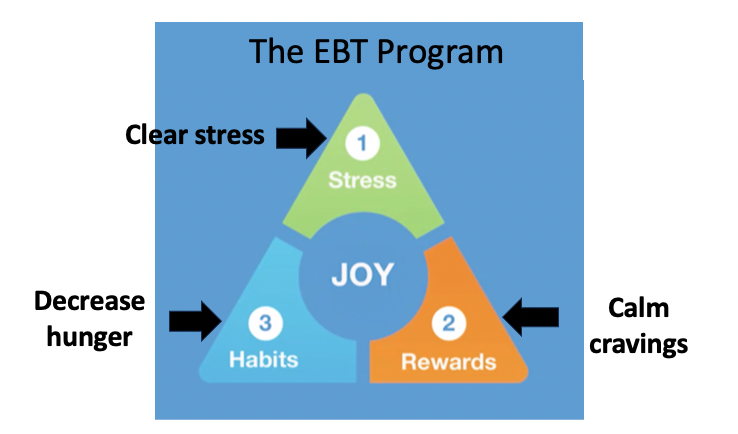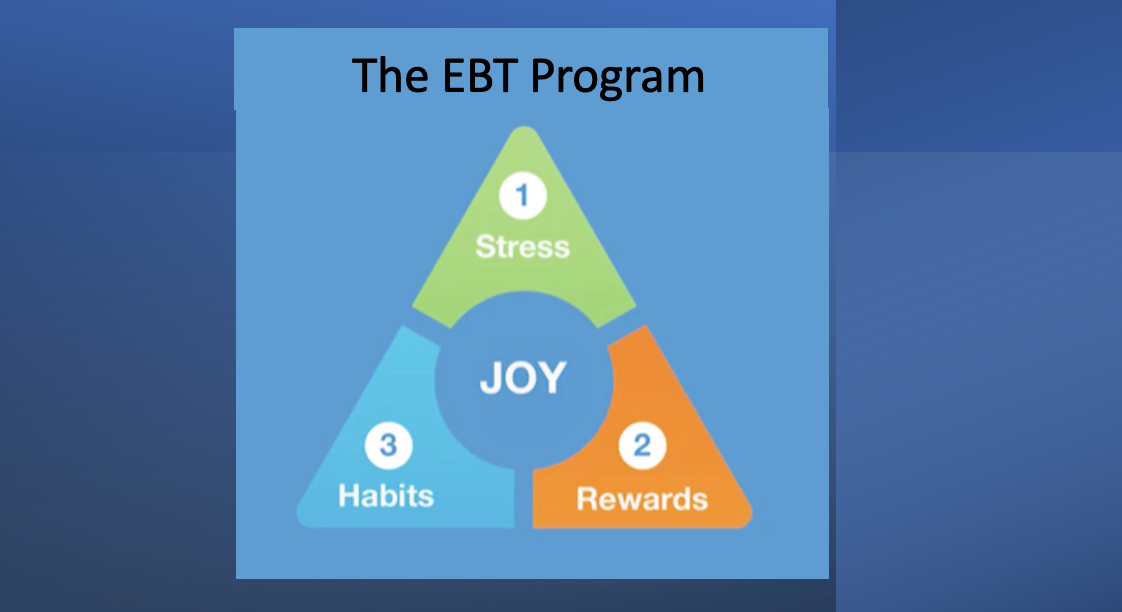There is so much fervor about weight loss drugs that one would think obesity is a condition of GLP-1 deficiency. It is not.
These drugs deliver an abnormal boost to GLP-1 receptors that decreases hunger and induces enough nausea to stop us from overeating. As overeating, not inactivity, is the primary culprit in weight gain, we lose weight.
What is the flaw in the approach?
As soon as the brain adjusts to these higher levels, weight plateaus, and we are back to the same old issue: it did not address the root cause of overeating and obesity.
These new weight loss drugs may be right for some people, but they have an inherent flaw that makes them fall short of a true solution. (EBT was previously named The Solution.) Although these drugs tinker with the biology that targets overeating, they stop short of treating the overarching cause: stress.
More people are stressed these days and can be diagnosed with Chronic Physiologic Stress Overload (CPSO). When the brain is stressed, the thinking brain is offline, so self-control is hampered, and we are more vulnerable to triggering the more than one hundred causes of obesity. CPSO activates biochemical drives to crave sugary, fatty, crunchy food, feel chronically hungry, depressed, and lethargic, and store extra energy preferentially as body fat.
Emotional Brain Training (EBT) treats CPSO. It rewires the brain circuits that cause the chronic activation of physiologic stress and "reactive triggers" that fuel appetites for chocolate cake and chips in amounts that lead to food hangovers and self-blame.
What problem are the drugs "solving"?
The weight loss drugs do not address the root cause of overeating and obesity (see Robert Lustig's review). They cause starvation, with nearly half of the weight loss coming from lean body mass, can trigger depression, and ultimately, do not fix the "stress problem." So, the pounds rapidly return once the drugs are stopped.
Then why are they in demand? It's desperation. Anyone who has binged on sweets or stuffed down chips at night knows it's not healthy, but they can't help but do it anyway. Our nation has embraced a cognitive/behavioral model of eating and weight and has forgotten about the emotional brain that controls our physiology.
People in high stress cannot "think" their way to stop overeating. They are frantic that nothing is working, and they feel out of control. As a health psychologist who has treated eating and weight problems for more than 40 years and as an ex-struggler with food and weight in my own life, I believe the cause of the problem is feeling out of control.
EBT addresses the root cause of obesity
What if we could get in control naturally? That's the role of Emotional Brain Training (EBT).
When people start practicing EBT, they enter the world of brain circuits, the ones that control our stress. We all have a huge supply of brain circuits stored in the amygdala that, when activated, control our physiology, emotions, thoughts, and behaviors. Processing our stress gives us the best shot at controlling our health, weight, hunger, eating, and lives.
It's remarkably simple. We all have some great circuits (resilient circuits) that spew chemicals that make us feel safe, rewarded, and satisfied, and some not-so-great circuits (reactive circuits) that cause us to feel threatened for no reason, completely unrewarded, and hungry.
We control them with EBT by thinking "circuits" instead of issues, and if we don't like what's going on with us, we blame a circuit. Then we use the EBT stress tools to switch off a reactive circuit and activate a resilient circuit. In that one act, legions of chemicals change, and we go from feeling bad to feeling good or great. Each switch ("spiral up") unleashes immediate physiological changes and rewires the offending circuit in small but important ways. Over time and with practice, changes can be lasting.
Gain control of your Stress Triangle
Why does switching circuits have so much power? When we switch off the offending circuit, we switch off three primitive structures in the emotional brain, specifically: the amygdala (stress center), VTA/nucleus accumbens (reward center), and the hypothalamus (hunger center).
Robert Lustig, MD and Michele Meitus-Snyder, MD proposed this "limbic triangle" in 2008, referring to the Bermuda Triangle, as once you enter the limbic triangle, it is virtually impossible to get out unassisted. Any yo-yo dieter can verify that!
I believe that their conceptualization of this triangle is brilliant because all these centers have multiple redundant pathways so that if you trigger one, you trigger them all. This makes being healthy such a challenge that our healthcare system has defaulted to the overuse of medications and surgery.
The good news about brain circuits
By processing our emotions, we can take charge of the circuits that control the limbic triangle. As these three structures impact our entire physiology, my colleagues Igor Mitrovic, MD, Scientific Director of EBT, Lynda Frassetto, MD, EBT Director of Clinical Research, and Michele Welling, MD, EBT Medical Director, and I have extended this model from obesity to all chronic diseases and mental health. We call it the Stress Triangle. When this triangle is chronically activated, health problems are likely to appear that reflect our genetic or environmental vulnerability,
Eating and weight are particularly sensitive to the activation of the Stress Triangle. Stress activates cortisol and extremes of dopamine, which cause strong drives for sugary, fatty, salty food. The hunger center shifts to starvation mode, slowing metabolism, causing that "always hungry" sensation, and promoting weight gain. This would indicate that learning skills to gain control of the Stress Triangle should be foundational to weight loss interventions.

A brain-based approach to overeating and overweight
The EBT Program follows the Stress Triangle's natural progression. The biological beginning of the drive for food starts when a reactive wire stored in the amygdala is activated by stress. The resulting stress takes the thinking brain offline, compromising our ability to exert conscious control, particularly when brownies or chips call us. So EBT begins by treating the amygdala . . .
Step 1: Clear Stress
In the early days of EBT, some 40 years ago, the shared environment wasn't that stressful, and most people could think their way out of stress, but times have changed. Our cognitive approaches no longer pass the stress test, and they are very slow.
We developed EBT to use emotions rather than thoughts in an innovative way so that no matter what stress level we are in, we can switch off stress and activate positive emotions. The skill set is called the EBT 5-Point System of Emotional and Behavioral Regulation. There are five skills, one for each of the five levels of stress in the brain, and each one delivers rapid stress relief.
Step 1 Prescription: Use EBT to clear stress 5 times per day, including before eating. Get your brain comfortable with spiraling up. Use pathway #1 on the EBT app, which can take about one to two minutes.
Step 2: Calm Cravings
Now that the brain is functioning better, the next step is to deal with the reward center, as if we are not amply rewarded by natural pleasures, the brain defaults to triggering dopamine highs and lows caused by artificial pleasures, such as sugary, fatty, salty, crunchy foods.
EBT uses "Joy Points" or self-administered surges of neurotransmitters to boost reward from four natural sources (happy memories, sensory pleasure, spiritual connection, and love and kindness).
Step 2 Prescription: Use EBT to clear stress 10 times per day and add enough Joy Points so you feel both safe and rewarded. Use pathways #1 (instant boost) and #2 (quick & easy) to broaden your stress skills.
Step 3: Decrease Hunger
Once we feel safe and rewarded, the biochemical drives to overeat will have faded and our sensitivity to internal cues of hunger and satiety will increase. This is a major shift in our relationship with food, as eating reasonably healthily becomes a nurturing act. We can choose food that effectively decreases hunger and boosts GLP-1 naturally.
Step 3 Prescription: Continue with your practice of spiraling up but learn how to use pathway #3 (deep work) which rewires the trauma circuits that contribute to stress overload. Add a flexible eating plan that emphasizes foods high in healthy fat and protein, which naturally decrease cravings and hunger.
Training the brain for lasting, natural results
These first three steps unlock the brain's natural resilience in an order that makes it easier to eat healthily and lose weight. But the ultimate benefit of EBT is that it has been shown to produce lasting changes.
Creating lasting changes in the circuits of the Stress Triangle takes using the method over time. EBT is the only drug-free, surgery-free weight program that research published in peer-reviewed journals has shown to promote lasting weight loss after treatment ends. See EBT research.
Much like a muscle, the emotional brain only changes with practice, except the practice is not lifting weights, but repetitions of the experience of switching off stress and activating joy. The EBT Program includes eight one-month courses to raise the brain's set point for lasting results. The program is available at the EBT Community Portal.
If you like the idea of a natural solution to eating and weight, join the EBT Community and drop in for our complimentary daily sessions with a Certified EBT Provider, start learning how to spiral up, and take control of your Stress Triangle.
The method is drug-free and affordable, and the tools are brain-based and proven. Best of all, once you learn the EBT skills, you have them for life.

